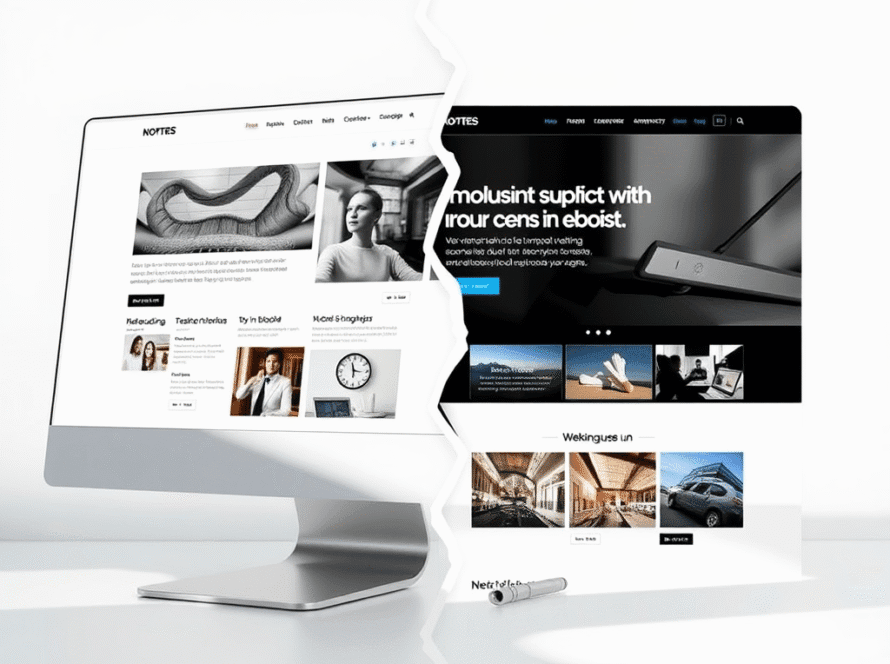Why accessibility and semantic structure matter for SEO (and your users)
The internet is a magical place… until your website tries to speak a language no one (and no thing) can understand.
Here’s the cold truth:
If Google can’t read your site properly, it’s not going to rank your site properly.
And if humans can’t navigate your site easily, they’re not going to stick around long enough to even matter.
You could have the best product, the slickest branding, the coolest marketing campaign — but if your site is built like a Jenga tower of divs and hacks, you’re basically invisible.
📚 Structure Isn’t Just for Looks
When you think about a website, you probably think about how it looks:
Is the design on-brand?
Are the images crisp?
Does it pop?
That’s important — but just as important (maybe even more) is how it’s built underneath.
The structure — the behind-the-scenes coding — is how search engines, accessibility tools, and users understand your content.
If you’ve ever used a screen reader, you’ll know: a website might look slick, but sound like an unstructured mess if it’s built without semantic tags.
Same with Google.
Your site needs to speak machine as fluently as it speaks human.
🔎 What is Semantic HTML (and Why Should You Care)?
Semantic HTML means using the right HTML tags that actually mean something.
Instead of throwing all content into endless <div> and <span> tags (which are meaningless containers), semantic HTML uses:
<h1> for main titles
<h2>, <h3>, <h4> for subtitles and sections
<p> for paragraphs
<nav> for navigation menus
<article> for standalone content pieces
<section> to define content areas
<footer> for footer information
<main> for the primary page content
It’s not about making things look good — CSS handles that.
It’s about making things understandable.
Semantic HTML Helps:
Search engines: Understand what’s important.
Screen readers: Navigate logically.
Developers: Maintain and scale your site faster.
Future-you: Avoids costly rebuilds when standards evolve.
If you care about SEO, accessibility, performance, and scalability (and you should)… you care about semantic structure.
🏆 SEO Loves Structure
When Googlebot visits your site, it’s trying to piece together:
What’s the page about?
What’s the most important information?
How is the content organized?
If the bot finds clean, well-structured content — logical headings, properly marked sections, internal links — it can quickly index your page and rank it appropriately.
If it finds a tangle of unlabelled divs and random styling hacks?
Confusion. Poor rankings. Lower visibility.
Real SEO Benefits of Semantic Structure:
Faster Indexing: Google understands your site faster and better.
Featured Snippets: Proper structure increases your chances.
Higher Rankings: Google rewards sites that make information accessible.
Rich Results: Structured data relies on proper page hierarchy.
At Bitstream Media, we don’t just chase “pretty” — we chase results.
🧑🦯 Accessibility Isn’t Optional Anymore
Beyond SEO, structure and readability are about real people.
Globally, over one billion people live with some form of disability. In Australia alone, that’s about 18% of the population.
Inaccessible websites:
Turn away potential customers
Damage your brand reputation
Risk legal consequences under anti-discrimination laws
How Structure Affects Accessibility:
Screen readers rely on heading structures to navigate pages.
Keyboard users depend on logical tab orders and skip links.
Cognitive users need clear, simple layouts without visual overload.
Building accessible websites isn’t just the right thing to do — it’s a smart business move.
(And bonus: Google’s algorithm loves accessibility too.)
🔥 Common Mistakes That Destroy Structure
Here are some real-world issues we’ve seen (and fixed):
Fake Headings: Designers styling paragraphs to look like headings instead of using real <h2> or <h3> tags.
Skipping Heading Levels: Jumping from <h1> straight to <h4>, confusing screen readers and bots.
Text in Images: Important information embedded in images without alt text = invisible to Google and unusable for many users.
No Landmarks: Pages built without clear <nav>, <main>, <section>, and <footer> areas.
Infinite Nested Divs: Code that looks like someone playing Jenga blindfolded.
Bitstream doesn’t play that game. Clean, logical, accessible structure every time.
🧠 Quick Checklist for Semantic, Accessible Structure
When building or auditing a website, check:
✅ One <h1> per page — the main title
✅ Headings are hierarchical: <h2> under <h1>, <h3> under <h2>, etc.
✅ Content divided with <section> and <article> tags where appropriate
✅ Navigation menus wrapped in <nav>
✅ Alt text added for every meaningful image
✅ Forms labelled properly with <label> tags
✅ Keyboard navigation tested
✅ Skip link to main content
✅ Clear page language declaration (<html lang=”en”>)
Follow this list, and you’ll already be ahead of half the internet.
📊 The Real-World Impact of Good Structure
Good structure isn’t just for compliance or SEO — it affects your bottom line.
Sites with better structure:
Load faster (less unnecessary code = less bandwidth)
Reduce bounce rates (users find what they need quicker)
Increase time on page (people stick around longer)
Boost conversions (easier to contact, purchase, or book)
According to research by SEMrush:
Pages in the top 10 Google results have better heading structure 95% of the time compared to lower-ranked pages.
Accessible sites convert 2x better on average than non-accessible counterparts.
That’s not a small edge — that’s business-changing.
🛠️ How Bitstream Media Builds With Structure In Mind
At Bitstream Media, accessibility and semantic structure aren’t “extras” you have to pay extra for.
They’re baked into every build.
What you get with us:
Thoughtful heading hierarchy
Semantic HTML5 markup
Accessibility best practices from day one
Fast, responsive performance
SEO-ready pages out of the gate
Human-first, robot-friendly design
Because at the end of the day, you’re building a site for real people — but those people have to find it first.
✋ Ready for a Website That’s Built to Be Seen, Read, and Loved?
If you want a website that makes sense to humans, search engines, and accessibility tools alike — you’re in the right place.
🌐 Visit bitstreammedia.com.au
Let’s build something the whole internet can actually understand.



